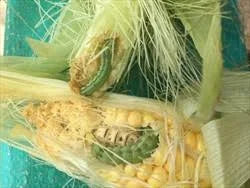This blog highlights the corn worm, a critical pest threatening maize crops. We will discuss how to identify this pest, the damage it causes, and implement effective management strategies. Gain insights on protecting your maize and maintaining a healthy crop.
What is Corn Worm in Maize?

The Helicoverpa armigera, also known as the corn earworm, cotton bollworm, is a major pest of maize (corn) and many other agricultural crops worldwide. This highly adaptable insect can wreak havoc on maize by feeding on various plant parts, leading to significant yield losses. Eggs are spherical in shape and creamy-white in color, laid singly on silk. There are five or six larval stages. The larva shows color variation from greenish to brown. It has dark brown-grey lines on the body with lateral white lines. Pupa is brown, rounded both anteriorly and posteriorly, with two tapering parallel spines at the posterior tip. Forewings of adult moths contain a line of seven to eight blackish spots on the margin and a black comma-shaped marking in the middle underside of each forewing.
Overview of Corn worm pest in maize
|
Scientific Name |
Helicoverpa armigera |
|---|---|
|
Common name |
Corn worm |
|
Attacking stage of pest |
Larval stage |
|
Affected parts of the plant |
Leaves, ears, silks, cobs |
Stages of Helicoverpa armigera in Maize:
- Egg Stage (3-10 days): Spherical, creamy-white eggs, laid singly on leaves, silks, or near ears.
- Larval Stage (2-6 weeks): 6 instars (growth stages) with increasing size and appetite.
- Later instars (2-4 weeks): Grow up to 24 mm, become more voracious.
- Pupal Stage (1-2 weeks): Brown, develop in the soil or inside ears.
- Adult Stage (1-2 weeks): Moth-like, nocturnal, lay eggs and continue the cycle.


Favorable factors for Helicoverpa armigera:
- Climate: Warm temperatures (25-35°C) and moderate rainfall (around 750 mm) provide optimal conditions for egg development, larval growth, and adult reproduction. Dry spells followed by rains can trigger egg-laying surges.
- Photoperiod: Longer daylight hours encourage egg-laying and larval development.
- Humidity: Moderate humidity (60-80%) promotes egg hatching and fungal growth on maize cobs, attracting H. armigera for egg-laying.
Initial Symptoms of corn worm infestation in Maize:
- Frass (caterpillar droppings): Green or brown pellets found on leaves, silks, and cobs indicate the presence of larvae.
- Wilting or drying of silks: This can occur due to larval feeding on the silks, disrupting pollen transmission and fertilization.
Severe Symptoms of corn worm infestation in Maize:
- Large holes in leaves and cobs: As larvae grow, they create larger feeding holes, compromising the plant's structure and exposing the developing kernels.
- Tunneling and feeding damage within cobs: Larvae burrow into the cob and feed on developing kernels, causing discoloration, rot, and yield loss.
Control measures for Helicoverpa armigera in maize:
Mechanical and biological method of control for corn worm in Maize
To effectively manage corn worm infestations, set up light traps at a rate of 1 per hectare. Additionally, place Helicoverpa sex pheromone traps at a density of 12 per hectare. For optimal control, apply NPV (Nuclear Polyhedrosis Virus) twice at 10-day intervals, using a concentration of 1.5 x 10^12 POB (polyhedral occlusion bodies) along with a mixture of 2.5 kg of crude sugar and 250 g of cotton seed kernel powder on the ear heads.
Chemical control measures for Corn worm in Maize
Spray the following mentioned insecticides for control of corn worm in Maize
|
Products |
Technical name |
Dosage |
|---|---|---|
|
Flubendiamide 39.35 % sc |
Rice-20ml/acre | |
| Aakramak |
Novaluron 5.25% + Emamectin benzonate 9 % w/w SC |
600 ml per/Acre |
|
Emamectin benzoate 5 % SG |
80-100 grams per Acre |
|
| Dissolves 100 ml of this product per 100 litre of water or 1 ml in 1 litre water and spray on leaves to cover 1 acre. |
FAQs related to Corn worm in Maize
Q. What is the scientific name for corn worm in maize?
A. Helicoverpa armigera
Q. Which insecticide is best for the control of Corn worm in Maize ?
A. Insecticides like Flubendiamide 39.35 % sc(Fluben), Novaluron 5.25%+ Emamectin benzoate 9% w/w SC(Aakramak), Emamectin benzoate 5% SG(EMA5)
Q. What are the symptoms of corn worm infestation in maize ?
A. Symptoms of corn worm infestation in maize include:
- Initial Symptoms: Presence of frass (green or brown droppings) on leaves, silks, and cobs, and wilting or drying of silks due to larval feeding.
- Severe Symptoms: Large holes in leaves and cobs, and tunneling within cobs where larvae feed on kernels, leading to discoloration, rot, and reduced yield.
Q. What is the corn worm pest in maize?
A. Corn worm pests in maize are caterpillars, such as the European Corn Borer and Fall Armyworm, that damage corn plants by feeding on the leaves and ears.
Q. Which is the best spray for corn worms?
A. Fluben (Flubendiamide 39.35% SC) is the best spray for corn worms in maize.










